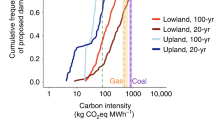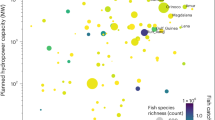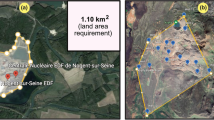Abstract
Hydropower is the most important renewable energy source to date, providing over 72% of all renewable electricity globally. Yet, only limited information is available on the global potential supply of hydropower and the associated costs. Here we provide a high-resolution assessment of the technical and economic potential of hydropower at a near-global scale. Using 15”×15” discharge and 3”×3” digital elevation maps, we built virtual hydropower installations at >3.8 million sites across the globe and calculated their potential using cost optimization methods. This way we identified over 60,000 suitable sites, which together represent a remaining global potential of 9.49 PWh yr−1 below US$0.50 kWh−1. The largest remaining potential is found in Asia Pacific (39%), South America (25%) and Africa (24%), of which a large part can be produced at low cost (<US$0.10 kWh−1). In an ecological scenario, this potential is reduced to 5.67 PWh yr−1.
This is a preview of subscription content, access via your institution
Access options
Access Nature and 54 other Nature Portfolio journals
Get Nature+, our best-value online-access subscription
$29.99 / 30 days
cancel any time
Subscribe to this journal
Receive 12 digital issues and online access to articles
$119.00 per year
only $9.92 per issue
Buy this article
- Purchase on Springer Link
- Instant access to full article PDF
Prices may be subject to local taxes which are calculated during checkout



Similar content being viewed by others
References
World Energy Outlook (International Energy Agency, Paris, 2016).
Hoogwijk, M. M. On The Global And Regional Potential Of Renewable Energy Sources. PhD thesis, Universiteit Utrecht, Faculteit Scheikunde (2004).
Köberle, A. C., Gernaat, D. E. H. J. & van Vuuren, D. P. Assessing current and future techno-economic potential of concentrated solar power and photovoltaic electricity generation. Energy 89, 739–56 (2015).
Pietzcker, R. C., Stetter, D., Manger, S. & Luderer, G. Using the Sun to decarbonize the power sector: The economic potential of photovoltaics and concentrating solar power. Appl. Energy 135, 704–20 (2014).
Arent, D. et al. Improved Offshore Wind Resource Assessment in Global Climate Stabilization Scenarios Contract No. NREL/TP-6A20-55049 (NREL; 2012).
World Energy Resources: Hydropower (World Energy Council, 2013).
Renewable Energy Technologies: Cost Analysis Series (IRENA, 2012).
IPCC Special Report on Renewable Energy Sources and Climate Change Mitigation: Hydropower (IPCC, 2011).
The International Journal on Hydropower & Dams. World Atlas & Industry Guide (Wallington, UK, 2013).
Fekete, B. M. et al. Millennium ecosystem assessment scenario drivers (1970-2050): Climate and hydrological alterations. Glob. Biogeochem. Cycles 24, GB0A12 (2010).
Lehner, B., Czisch, G. & Vassolo, S. The impact of global change on the hydropower potential of Europe: A model-based analysis. Energy Policy 33(7), 839–55 (2005).
Pokhrel, Y. N., Oki, T., Kanae, S. A grid based assessment of global theoretical hydropower potential. Ann. J. Hydraul. Eng. 52, 712 (2008).
Labriet, M. et al. Uncertainty analyses in TIAM, ERMITAGE WP8 Climate and Energy/Technology Deliverable 8.1 (2013).
Zhou, Y., Hejazi, M., Smith, S., Edmonds, J., Li, H. & Clarke, L. et al. A comprehensive view of global potential for hydro-generated electricity. Energy Environ. Sci. 8, 2622–2633 (2015).
Hoes, O. A., Meijer, L. J., Van Der Ent, R. J. & Van De Giesen, N. C. Systematic high-resolution assessment of global hydropower potential. PLOS ONE. 12, e0171844 (2017).
New Stream-reach Development: A Comprehensive Assessment of Hydropower Energy Potential in the United States (Oak Ridge National Laboratory, Oak Ridge, 2014).
Lehner, B., Verdin, K. & Jarvis, A. New global hydrography derived from spaceborne elevation data. Eos, Trans. AGU 89, 93–94 (2008).
Bondeau, A. et al. Modelling the role of agriculture for the 20th century global terrestrial carbon balance. Glob. Change Biol. 13, 679–706 (2007).
Biemans, H. et al. Effects of precipitation uncertainty on discharge calculations for main river basins. J. Hydrometeorol. 10, 1011–25 (2009).
Rost, S. et al. Agricultural green and blue water consumption and its influence on the global water system. Water Resour. Res. http://dx.doi.org/10.1029/2007WR006331 (2008).
Gerten, D., Schaphoff, S., Haberlandt, U., Lucht, W. & Sitch, S. Terrestrial vegetation and water balance—hydrological evaluation of a dynamic global vegetation model. J. Hydrol. 286, 249–70 (2004).
Biemans, H. et al. Future water resources for food production in five South Asian river basins and potential for adaptation—A modeling study. Sci. Total Environ. 468, S117–S31 (2013).
Bijl, D. L., Bogaart, P. W., Kram, T., de Vries, B. J. & van Vuuren, D. P. Long-term water demand for electricity, industry and households. Environ. Sci. Policy 55, 75–86 (2016).
Wagner, H.-J., Mathur, J. Introduction to Hydro Energy Systems — Basics, Technology and Operation (Springer, Berlin Heidelberg, 2011).
Cost Base for Hydropower Plants (with a Generating Capacity of More than 10 000 kW) (Norwegian Water Resources and Energy Directorate (NVE), Oslo, 2012).
Hall, D. G., Hunt, R. T., Reeves, K. S., Carroll, G. R. Estimation of Economic Parameters of US Hydropower Resources Contract No. INEEL/EXT-03-00662 (Idaho National Engineering and Environmental Laboratory, 2003).
Stehfest, E. et al. Integrated Assessment of Global Environmental Change with IMAGE 3.0 - Model Description and Policy Applications (PBL The Netherlands Environmental Assessment Agency, 2014).
FAOSTAT Database Collections (Food and Agriculture Organization of the United Nations, 2013).
Lehner, B. et al. High resolution mapping of the world’s reservoirs and dams for sustainable river flow management: GRanD Database (V1.0). Front. Ecol. Environ. 9, 494–502 (2011).
The World Database on Protected Areas (WDPA) (UNEP-WCMC, Cambridge, UK, 2015).
Janse, J. et al. GLOBIO-Aquatic, a global model of human impact on the biodiversity of inland aquatic ecosystems. Environ. Sci. Policy 48, 99–114 (2015).
Riahi, K. et al. RCP 8.5—A scenario of comparatively high greenhouse gas emissions. Climatic Change 109, 33 (2011).
Warszawski, L. et al. The inter-sectoral impact model intercomparison project (ISI–MIP): project framework. Proc. Natl Acad. Sci. USA 111, 3228–32 (2014).
Ziv, G., Baran, E., Nam, S., Rodríguez-Iturbe, I. & Levin, S. A. Trading-off fish biodiversity, food security, and hydropower in the Mekong River Basin. Proc. Natl Acad. Sci. USA 109, 5609–5614 (2012).
Magilligan, F. J. & Nislow, K. H. Changes in hydrologic regime by dams. Geomorphology 71, 61–78 (2005).
Wisser, D., Frolking, S., Hagen, S. & Bierkens, M. F. Beyond peak reservoir storage? A global estimate of declining water storage capacity in large reservoirs. Water Resour. Res. 49, 5732–5739 (2013).
House, N., House, H. House, D., Hafen, T., House, R. Power from the Glens (Scottish Hydro Electric, 2005).
Hagemann, S. et al. Climate change impact on available water resources obtained using multiple global climate and hydrology models. Earth Syst. Dynam. 4, 129–44 (2013).
Magirl, C. S., Olsen, T. D. Navigability Potential of Washington Rivers and Streams Determined with Hydraulic Geometry and a Geographic Information System Contract No. 5122 (U.S. Department of the Interior & US Geological Survey, 2009).
Bright, E. A., Coleman, P. R. & Rose, A. N. Landscan 2010 (Oak Ridge National Laboratory, Oak Ridge, TN, 2011).
Kunte, A., Hamilton, K., Dixon, J. & Clemens, M. Estimating National Wealth: Methodology and Results (Environment Department, 1998).
Commodity Price Data (The Pink Sheet) (World Bank, 2015).
Annual Producer Prices (Food and Agriculture Organization of the United Nations, 2015).
Project Power Networks (OpenStreetMap, 2015).
Harris, J., Bonneville, D., Kersting, R. A., Lawson, J. & Morris, P. Cost Analyses and Benefit Studies for Earthquake-Resistant Construction in Memphis, Tennessee Report 14-917-26 (NISTGCR, 2013).
Global Economic Monitor (World Bank, 2014).
Jackson, S. & Sleigh, A. Resettlement for China’s Three Gorges Dam: socio-economic impact and institutional tensions. Communist Post-Communist Stud. 33, 223–41 (2000).
Cernea, M. M. The Economics of Involuntary Resettlement — Questions and Challenges (World Bank, 1999).
Acknowledgements
C. Ettema is acknowledged for editing part of the manuscript. Moreover, the study benefitted from FP7/2007-2013 financial support under grant agreement number 308329 (ADVANCE).
Author information
Authors and Affiliations
Contributions
D.E.H.J.G. and P.W.B. conceived the idea and developed the modelling techniques. D.P.v.V. assisted in refining the idea and manuscript. H.B. provided climate input data and R.N. assisted in preparatory analyses. D.E.H.J.G. drafted the manuscript. All authors discussed the results and contributed to the manuscript.
Corresponding author
Additional information
Publisher’s note: Springer Nature remains neutral with regard to jurisdictional claims inpublished maps and institutional affiliations.
Electronic supplementary material
Supplementary Information
Supplementary Tables 1–5, Supplementary Figures 1–3 and Supplementary References
Rights and permissions
About this article
Cite this article
Gernaat, D.E.H.J., Bogaart, P.W., Vuuren, D.P.v. et al. High-resolution assessment of global technical and economic hydropower potential. Nat Energy 2, 821–828 (2017). https://doi.org/10.1038/s41560-017-0006-y
Received:
Accepted:
Published:
Issue Date:
DOI: https://doi.org/10.1038/s41560-017-0006-y
This article is cited by
-
Hydropower expansion in eco-sensitive river basins under global energy-economic change
Nature Sustainability (2024)
-
Sustainable pathways towards universal renewable electricity access in Africa
Nature Reviews Earth & Environment (2024)
-
Avoiding ecosystem and social impacts of hydropower, wind, and solar in Southern Africa’s low-carbon electricity system
Nature Communications (2024)
-
Global Dam Tracker: A database of more than 35,000 dams with location, catchment, and attribute information
Scientific Data (2023)
-
A global-scale framework for hydropower development incorporating strict environmental constraints
Nature Water (2023)



